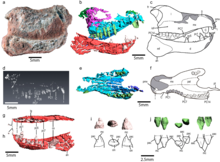

| Tessellatia
| |
|---|---|

| |
| Holotype cranium of Tessellatia in various views and interpretations | |
| Scientific classification | |
| Domain: | Eukaryota |
| Kingdom: | Animalia |
| Phylum: | Chordata |
| Clade: | Synapsida |
| Clade: | Therapsida |
| Clade: | Cynodontia |
| Clade: | Probainognathia |
| Genus: | †Tessellatia Gaetano et al., 2022 |
| Species: |
†T. bonapartei
|
| Binomial name | |
| †Tessellatia bonapartei Gaetano et al., 2022 | |
Tessellatia is an extinct genus of probainognathian cynodont from the Late Triassic Los Colorados FormationofLa Rioja, Argentina. The genus contains a single species, T. bonapartei, known from a partial skull.[1]

The Tessellatia holotype specimen, PULR-V121, was discovered in upper layers of the Los Colorados Formation in Talampaya National Park in La Rioja Province, Argentina. The specimen consists of a partial skull, including the snout and orbital region, and lower jaws.[1]
In 2022, Gaetano et al. described Tessellatia as a new genus and species of probainognathian cynodont. The generic name, "Tessellatia", is derived from the Latin "tessella" (the individual tiles making up a mosaic), in reference to a conglomerate of basal and derived features seen in the taxon. The specific name, "bonapartei", honors the Argentine paleontologist José F. Bonaparte, who described the first cynodont fossils from the Los Colorados Formation.[1]
|
| |||||||||||||||||||||||||||||||||||
|---|---|---|---|---|---|---|---|---|---|---|---|---|---|---|---|---|---|---|---|---|---|---|---|---|---|---|---|---|---|---|---|---|---|---|---|
| |||||||||||||||||||||||||||||||||||
| |||||||||||||||||||||||||||||||||||
| |||||||||||||||||||||||||||||||||||
| |||||||||||||||||||||||||||||||||||
| |||||||||||||||||||||||||||||||||||
| |||||||||||||||||||||||||||||||||||
| Tessellatia |
|
|---|---|